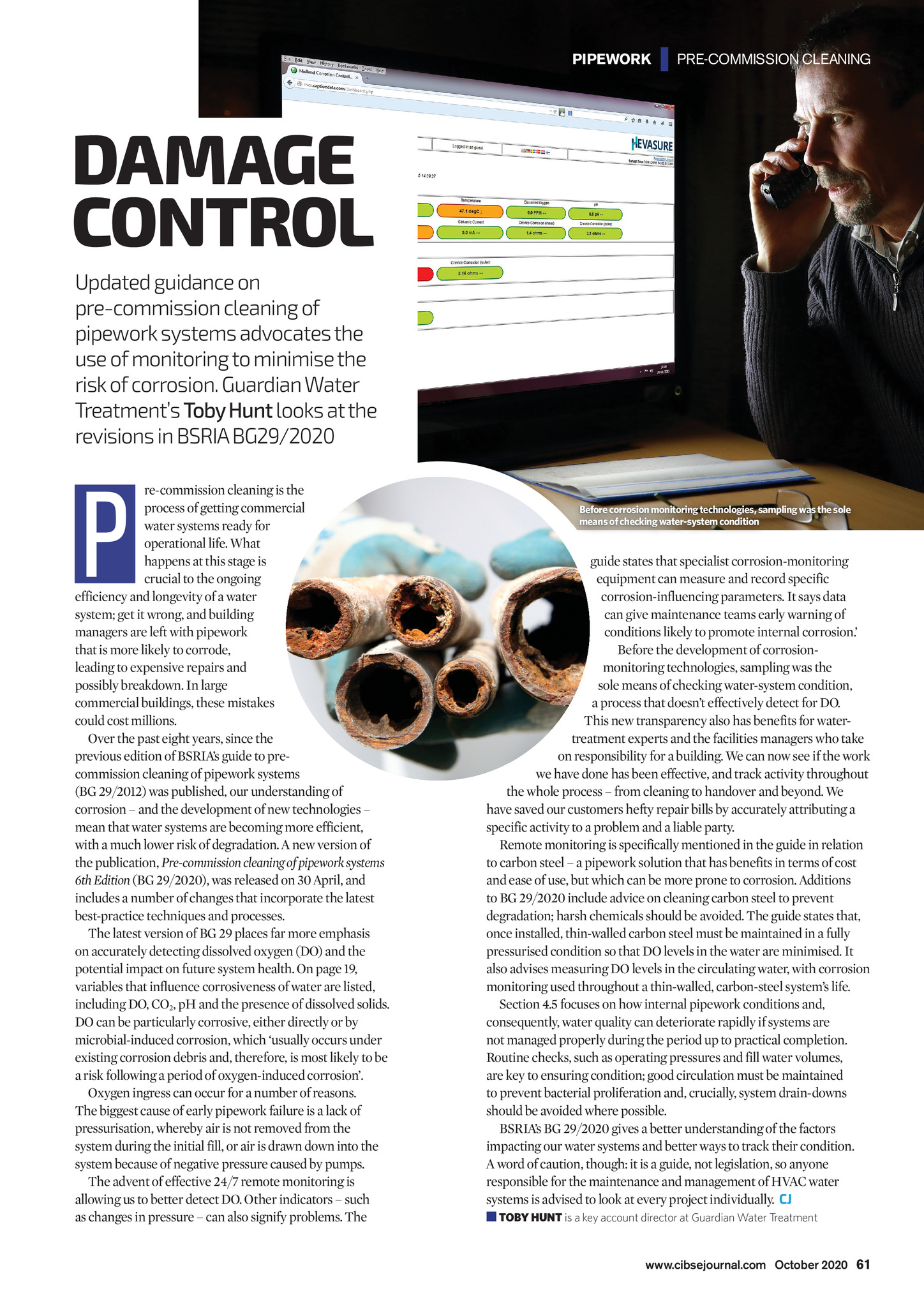


PIPEWORK | PRE-COMMISSION CLEANING DAMAGE CONTROL Updated guidance on pre-commission cleaning of pipework systems advocates the use of monitoring to minimise the risk of corrosion. Guardian Water Treatments Toby Hunt looks at the revisions in BSRIA BG29/2020 P re-commission cleaning is the process of getting commercial water systems ready for operational life. What happens at this stage is crucial to the ongoing efficiency and longevity of a water system; get it wrong, and building managers are left with pipework that is more likely to corrode, leading to expensive repairs and possibly breakdown. In large commercial buildings, these mistakes could cost millions. Over the past eight years, since the previous edition of BSRIAs guide to precommission cleaning of pipework systems (BG 29/2012) was published, our understanding of corrosion and the development of new technologies mean that water systems are becoming more efficient, with a much lower risk of degradation. A new version of the publication, Pre-commission cleaning of pipework systems 6th Edition (BG 29/2020), was released on 30 April, and includes a number of changes that incorporate the latest best-practice techniques and processes. The latest version of BG 29 places far more emphasis on accurately detecting dissolved oxygen (DO) and the potential impact on future system health. On page 19, variables that influence corrosiveness of water are listed, including DO, CO2, pH and the presence of dissolved solids. DO can be particularly corrosive, either directly or by microbial-induced corrosion, which usually occurs under existing corrosion debris and, therefore, is most likely to be a risk following a period of oxygen-induced corrosion. Oxygen ingress can occur for a number of reasons. The biggest cause of early pipework failure is a lack of pressurisation, whereby air is not removed from the system during the initial fill, or air is drawn down into the system because of negative pressure caused by pumps. The advent of effective 24/7 remote monitoring is allowing us to better detect DO. Other indicators such as changes in pressure can also signify problems. The Before corrosion monitoring technologies, sampling was the sole means of checking water-system condition guide states that specialist corrosion-monitoring equipment can measure and record specific corrosion-influencing parameters. It says data can give maintenance teams early warning of conditions likely to promote internal corrosion. Before the development of corrosionmonitoring technologies, sampling was the sole means of checking water-system condition, a process that doesnt effectively detect for DO. This new transparency also has benefits for watertreatment experts and the facilities managers who take on responsibility for a building. We can now see if the work we have done has been effective, and track activity throughout the whole process from cleaning to handover and beyond. We have saved our customers hefty repair bills by accurately attributing a specific activity to a problem and a liable party. Remote monitoring is specifically mentioned in the guide in relation to carbon steel a pipework solution that has benefits in terms of cost and ease of use, but which can be more prone to corrosion. Additions to BG 29/2020 include advice on cleaning carbon steel to prevent degradation; harsh chemicals should be avoided. The guide states that, once installed, thin-walled carbon steel must be maintained in a fully pressurised condition so that DO levels in the water are minimised. It also advises measuring DO levels in the circulating water, with corrosion monitoring used throughout a thin-walled, carbon-steel systems life. Section 4.5 focuses on how internal pipework conditions and, consequently, water quality can deteriorate rapidly if systems are not managed properly during the period up to practical completion. Routine checks, such as operating pressures and fill water volumes, are key to ensuring condition; good circulation must be maintained to prevent bacterial proliferation and, crucially, system drain-downs should be avoided where possible. BSRIAs BG 29/2020 gives a better understanding of the factors impacting our water systems and better ways to track their condition. A word of caution, though: it is a guide, not legislation, so anyone responsible for the maintenance and management of HVAC water systems is advised to look at every project individually. CJ TOBY HUNT is a key account director at Guardian Water Treatment www.cibsejournal.com October 2020 61 CIBSE October 2020 p61 Water quality guide.indd 61 25/09/2020 16:49